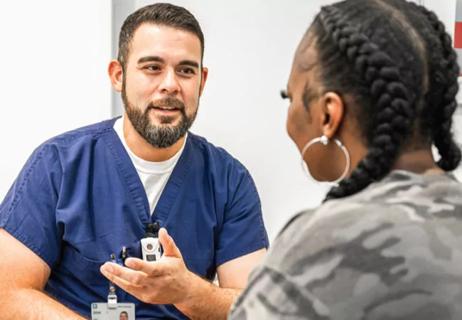Advertisement
Multidisciplinary approach starts with early and regular screenings

Before the development of a widespread understanding of postpartum depression (PPD), some women were destined to suffer profoundly during peripartum. It wasn’t until 1994 that PPD made it into the Diagnostic and Statistical Manual of Mental Disorders, where it is categorized as a subtype of major depressive disorder (MDD). Even today, some mothers experience guilt, confusion and embarrassment about experiencing PPD symptoms during a time the world expects them to be joyful.
Advertisement
Cleveland Clinic is a non-profit academic medical center. Advertising on our site helps support our mission. We do not endorse non-Cleveland Clinic products or services. Policy
As the science around PPD has advanced, so has awareness, screening and treatment. This August, a decision is expected from the U.S. Food & Drug Administration regarding zuranolone, a 14-day oral treatment for PPD and MDD that acts as a positive allosteric modulator of the GABA A receptor. Unlike traditional antidepressants, which begin to show effectiveness after four to eight weeks, in clinical trials zuranolone has shown effectiveness as soon as three days.
At Cleveland Clinic, doctors expect zuranolone to be a boon for PPD treatment. As the first fast-acting oral medication to treat the condition, it will be part of the health system’s robust toolkit for caring for patients who have or are at risk for developing PPD.
“For the longest time, postpartum depression wasn’t adequately discussed, and patients and providers felt uncomfortable talking about it,” says Catherine Caponero, DO, a physician in Cleveland Clinic’s Ob/Gyn & Women’s Health Institute. “Now we know not only how prevalent it is, but that it’s just like other medical conditions we need to care for during pregnancy. Just like preeclampsia or diabetes, we need to identify the condition and adequately treat it.”
Zuranolone is poised to improve on significant strides made in 2019 with FDA approval of brexanolone, the first fast-acting anti-depressant approved for PPD, says Lara Feldman, DO, a psychiatrist in Cleveland Clinic’s Center for Behavioral Health. Brexanolone is given via a 60-hour continuous infusion that must be delivered during an inpatient stay, since excessive sedation is one of the risks requiring a Risk Evaluation and Mitigation Strategy (REMS) program.
However, no cases of loss of consciousness have been seen in clinical trials with zuranolone. An approval decision on zuranolone is expected from the FDA by Aug. 5, including whether a REMS program is needed. The U.S. Drug Enforcement Administration then has up to 90 days to decide whether zuranolone should be scheduled.
The health system’s experience with brexanolone has been extremely positive.
“Women show dramatic improvement in mood, affect and anxiety in 60 hours. Women who were unable to care for their babies become motivated to take care of them,” says Dr. Feldman. “The bond is immediately improved.”
The majority, adds Dr. Feldman, remain in remission from a recurrence of PPD after the single infusion. Cleveland Clinic has followed these patients for up to a year.
During treatment with zuranolone, women will be advised not to breastfeed, but can pump and discard their milk to maintain their supply, adds Dr. Caponero.
Advertisement
Although this medication is still in the process of obtaining FDA approval, it has the potential to particularly help women who would struggle to step away from their families for three days to care for themselves.
“We’re excited about the fact that there’s an outpatient treatment on the horizon,” says Dr. Caponero. Drs. Caponero and Feldman expect there will still be a role for brexanolone, perhaps for the most severe PPD cases.
According to the Office on Women’s Health at the U.S. Department of Health and Human Services, one in 9 new mothers has postpartum depression. Those who have a history of anxiety or depression, or who have previously experienced PPD, are at higher risk. The condition can show up anytime between the last three months of pregnancy to a year postpartum, which is why Cleveland Clinic stresses regular screenings.
“All of the hormone shifts during pregnancy and postpartum, as well as the sleep deprivation that new mothers experience, can trigger depression,” says Dr. Caponero. “That’s why we must be extra cautious, especially in our society. A lot of women are by themselves or have smaller social networks, and family may be all over the country. There just isn’t the support that a lot of women need in the immediate postpartum period.”
Advertisement
Cleveland Clinic is piloting a project that includes administering the Patient Health Questionnaire-2 (PHQ-2), a two-question validated depression screening, at the first prenatal visit. It also is given again at the start of the third trimester, and during the postpartum periods at OB and at every pediatrician appointment for the first six months. Patients who fail the short questionnaire take the longer Edinburgh Postnatal Depression Scale screening. If treatment is deemed necessary, patients are typically referred for therapy and prescribed medication.
“We do talk with patients about risks of being on medications during pregnancy,” says Dr. Caponero. “But for the most part, the risks associated with changing medication are less than the risk of inadequately treated depression in pregnancy.”
One of the most important factors in Cleveland Clinic’s approach to caring for women with postpartum depression is a multidisciplinary approach, she says.
“Care is coordinated among specialists in OB, psychiatry, nursing and pharmacy,” says Dr. Caponero. “There are a lot of moving pieces, but we’ve been able to work really well together to make a life-changing impact on these women’s lives.”
Advertisement
Advertisement

Multidisciplinary program helps budding clinicians explore the human dimensions of patient care and medical research

Program empowers Black stylists to provide emotional first aid

Positive emotions, low impulsivity appear to safeguard against weight gain, other comorbidities

Consultation service provides comprehensive care to patients with anxiety, PTSD, schizophrenia, and other high-risk disorders

Study shows a growing openness to the clinical potential of psychedelic treatments

Urine test strips and point-of-care testing may be key to slowing opioid epidemic

Study sheds light on how clinicians addressed their patients’ pain and insomnia during the pandemic

Recovery's in Reach provides treatment options, peer support to those struggling with alcohol and drug use